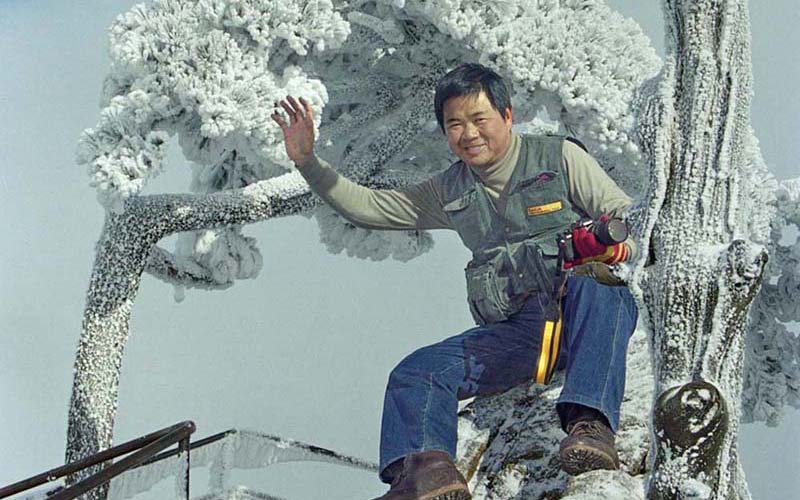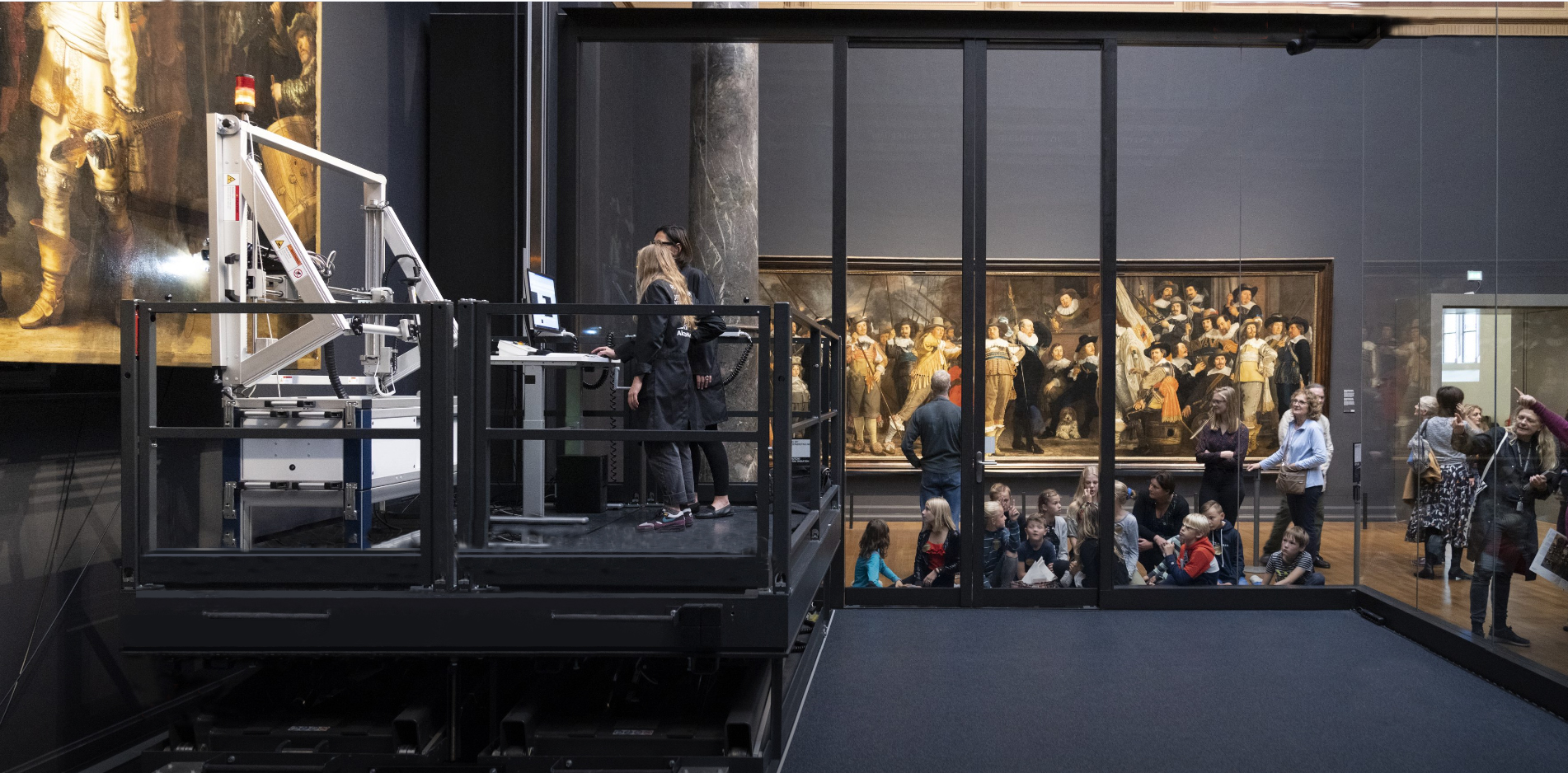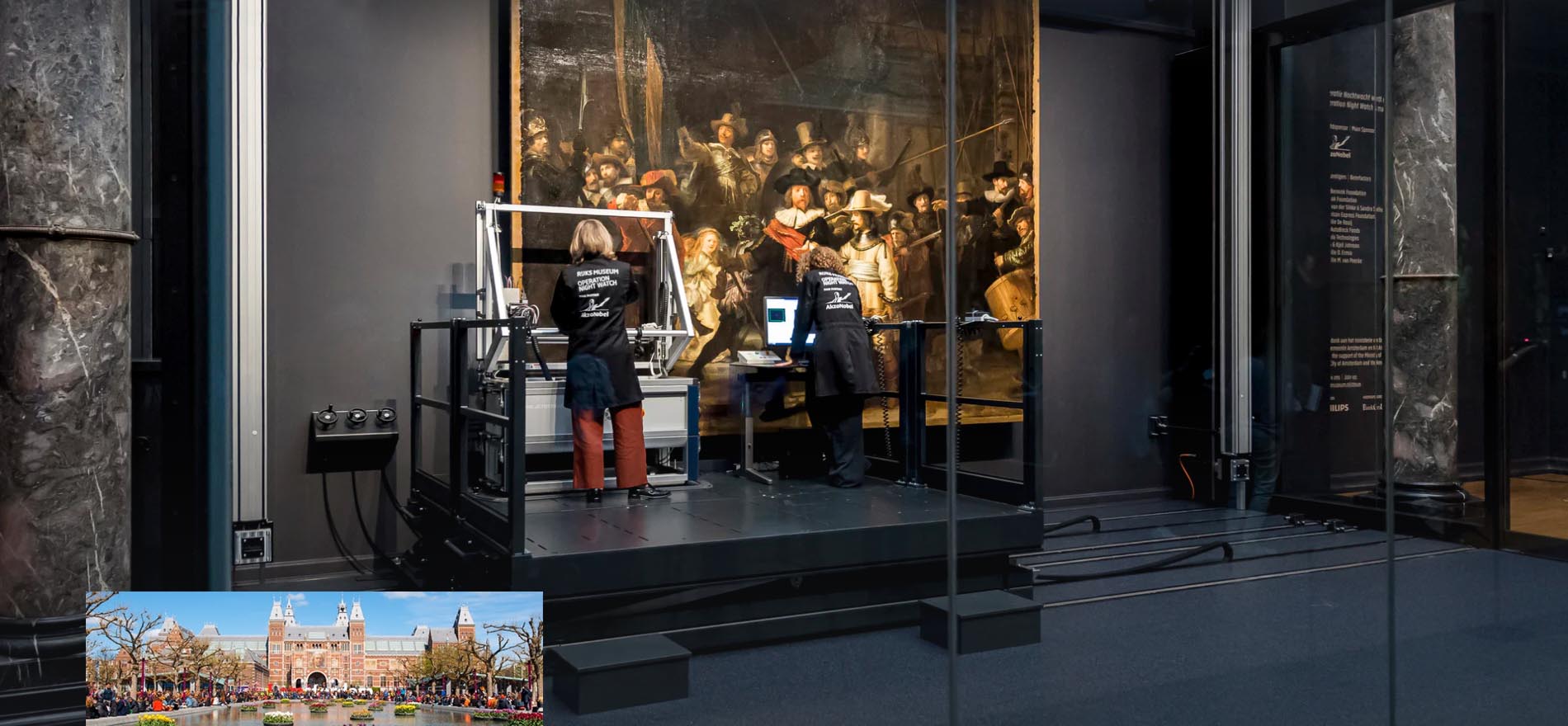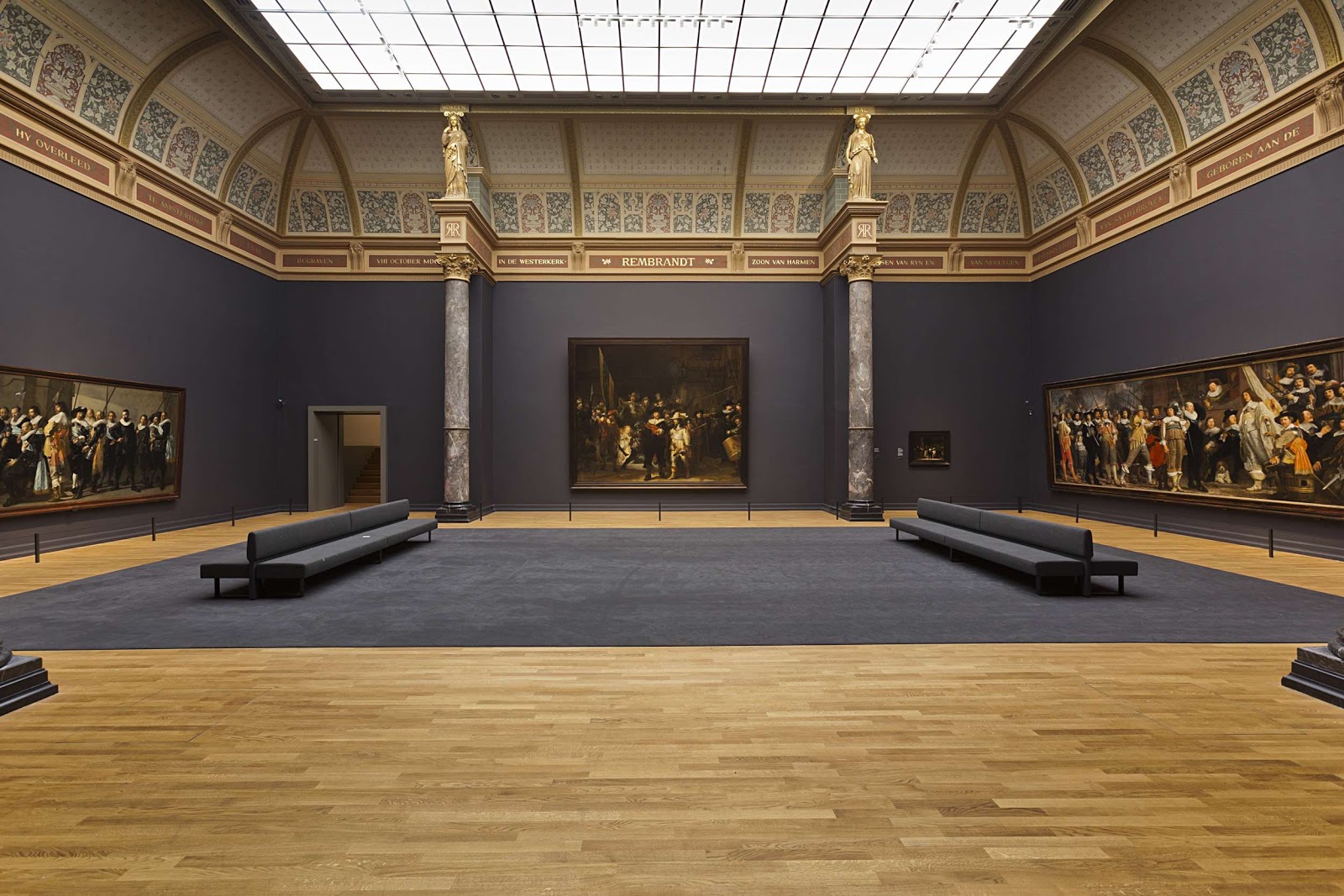Frans Hals (1582/1583–1666) and Pieter Codde (1599–1678)
Militia Company of District XI under the Command of Captain Reynier Reael, Known as ‘The Meagre Company’
from 1633 until 1637
Height: 209 cm (82.2 in); Width: 429 cm (14 ft)
Hals was commissioned to paint this civic guard portrait in 1633. By 1636 the work was still unfinished and the commission went to Codde, who finished it a year later. Hals is said to have done the left side of the painting, up to the man in light clothes in the centre, as well as many of the hands and faces. The rest is by Codde.
Frans Hals (1582/83–1666) painted no fewer than six militia pieces: portraits of groups of armed civilians who, in the seventeenth-century, maintained order as a neighbourhood watch and, if necessary, defended the city against attackers. The first portrait of this type dates from 1616 and the last one from 1639. Not many other seventeenth-century Dutch painters are known to have had such a large production. Hals’ loose brush technique and his unique, lively compositions make these paintings a feast for the eye. Frans Hals can therefore safely be called Master of the militia piece.
Special assignment
In 1633 Hals received a special assignment from Amsterdam. The officers of the new urban district 11, Captain Reynier Reael and Lieutenant Cornelis Michielsz Blaeuw, commissioned him to make a group portrait of the members of their company. At the time it was highly unusual to award such an assignment to a painter outside one’s own city.
Pieter Codde
Three years later, the work was still not finished. The officers urged Hals to finish the work, even offered him extra money, but Hals said he did not want to come to Amsterdam. The guard then decided to have the work finished by a painter from within their own ranks: Pieter Codde. Codde had never made a militia piece before. He usually painted very delicately and in a small format. For The Meagre Company he tried to imitate Hals’ loose style as closely as possible. He did this so well that to this very day it is not entirely clear which parts were painted by Codde.

Rembrandt van Rijn
The Company of Frans Banning Cocq and Willem van Ruytenburgh, known as the ‘Night Watch’.
1642
Height: 379.5 cm (12.4 ft); Width: 453.5 cm (14.8 ft)
Frans Banning Cocq, heer van purmerlant en Ilpendam, Capiteijn Willem van Ruijtenburch van Vlaerdingen, heer van Vlaerdingen, Luijtenant, Jan Visscher Cornelisen Vaendrich, Rombout Kemp Sergeant, Reijnier Engelen Sergeant, Barent Harmansen, Jan Adriaensen Keyser, Elbert Willemsen, Musketier Jan Clasen Leydeckers (behind the Lieutenant in Yellow blowing into the powder pan of a musket which once belonged to Jan Snedeker), Jan Ockersen, Jan Pietersen bronchorst, Harman Iacobsen wormskerck, Jacob Dirksen de Roy (the Governor on far left of the cut off section of the painting), Jan vander heede, Walich Schellingwou, Jan brugman, Claes van Cruysbergen, Paulus Schoonhoven
Signature and date bottom center: Rembrandt f 1642
Inscriptions :
top center:

Bartholomeus van der Helst (1613–1670)
Officers and Other Members of the Militia of District VIII in Amsterdam Led by Captain Roelof Bicker and Lieutenant Jan Michielsz. Blaeuw
Between 1639 and 1643
Height: 235 cm (92.5 in); Width: 750 cm (24.6 ft)
The company of captain Roelof Bicker and lieutenant Jan Michielsz. Blaeuw outside the De Haan brewery in the Lastage district (corner Geldersekade-Boomsloot) in Amsterdam, 1639. The people portrayed are: Pieter Hulft (vaandrig), Dirck de Lange (sergeant), Jochem Rendorp (sergeant), Hendrick Gerritsz. Velthoen, Jan Jorisz. Eenhoorn, Coenraet Rogiersz. Ramsden, Johannes Rombouts, Willem Jansz. Steenwijck, Jan Hulft, Claes Rotterdam, Clemens van Sorgen, Jan Martensz. Troost, Hendrick Jansz. Dommer, Paulus van Walbeeck, Jan Cornelisz. Moyaert, Hendrik Jorisz. Fuyck, Abraham Pietersz. Kroock, Cornelis Wilkens, Adriaen Jorisz. Eenhoorn, Isaac van de Venne, Jan Cornelisz. Pronk, Gerrit Jacobsz. Indischerave, Dirck Joosten Rijskamp, Renier Redinckhoven, Wynant Arentsz. Oppyn en Cornelis Wilkens Jr. On the far left the painter portrayed himself.
Signature and date bottom left: B. vander Helst f. 163[9]
Inscriptions :
on the frame:
Roelof Bicker, Capiteyn. - Ian Michielse.Blauw, Luijt. - Pieter Hulft, Vaandrigh. - Dirck de Lange, Sergeant. - Iochem Rendorp, Sergeant. / Hendrick Gerritz.Velthoen. - Ioris Ioriszen.Eenhoorn. - Coenraet Rogiersz.Ramfden. - Iohannes.Rombouts. - Willem Ianfze.Steenwijck. / Ian Hulft. - Claes Rotterdam - Clement van Sorgen. - Ian Martenfze.Trooft. - Hendrick Ianfze.Dommer / Paulus van Walbeeck. - Ian Cornelisz.Moijaert. - Hendrick Iroisze.Fuijck. - Abraham Pieterfz. kroock. - Cornelis Wilkens. / Adriaen Iorisz.Eenhoorn - Ifaac vende.Venne. - Ian Cornelisze.Pronck. - Gerrit Iacobsze.Indifcherave. - Dirck Ioosten.Rijfkamp. / Reijmer Redinckhoven. - Wijnant Arentsz.Oppijn. - Cornelis Wilkens de Jonge. - ANNO M.D.C.XLIII.
Operation Night Watch
The largest research and conservation project ever for 'The Night Watch' has started. This is happening live in the museum for you to see.
https://www.rijksmuseum.nl/en/nightwatch
Dive into the Night Watch
Step across the red cord, take captain Frans Banninck Cocq’s hand, zoom in and let yourself be carried away into the world of the Night Watch.
Operation Night Watch is the largest research and conservation project ever on 'the Night Watch'. The Rijksmuseum invites members of the public to watch the entire process at the museum and online.
Commissioned in 1642 by the mayor and leader of the civic guard of Amsterdam, Frans Banninck Cocq, to create a group portrait of his shooting company, the Night Watch is recognised as one of the most important works of art in the world today and hangs in the specially designed “Gallery of Honour” at the Rijksmuseum. It is more than 40 years since the Night Watch underwent its last major restoration, following an attack on the painting in 1975.
The Night Watch will be encased in a state-of-the-art clear glass chamber designed by the French architect Jean Michel Wilmotte. This will ensure that the painting can remain on display for museum visitors. A digital platform will allow viewers from all over the world to follow the entire process online continuing the Rijksmuseum innovation in the digital field.
Taco Dibbits, General Director Rijksmuseum: The Night Watch is one of the most famous paintings in the world. It belongs to us all, and that is why we have decided to conduct the restoration within the museum itself – and everyone, wherever they are, will be able to follow the process online.
The Rijksmuseum continually monitors the condition of the Night Watch, and it has been discovered that changes are occurring, such as the blanching on the dog figure at the lower right of the painting. To gain a better understanding of its condition as a whole, the decision has been taken to conduct a thorough examination. This detailed study is necessary to determine the best treatment plan, and will involve imaging techniques, high-resolution photography and highly advanced computer analysis. Using these and other methods, we will be able to form a very detailed picture of the painting – not only of the painted surface, but of each and every layer, from varnish to canvas.
A great deal of experience has been gained in the Rijksmuseum relating to the restoration of Rembrandt’s paintings. Last year saw the completion of the restoration of Rembrandt’s spectacular portraits of Marten Soolmans and Oopjen Coppit. The research team working on the Night Watch is made up of researchers, conservators and restorers from the Rijksmuseum, which will conduct this research in close collaboration with museums and universities in the Netherlands and abroad.
The Night Watch
The group portrait of the officers and other members of the militia company of District II, under the command of Captain Frans Banninck Cocq and Lieutenant Willem van Ruytenburch, now known as the Night Watch, is Rembrandt’s most ambitious painting. This 1642 commission by members of Amsterdam’s civic guard is Rembrandt’s first and only painting of a militia group. It is celebrated particularly for its bold and energetic composition, with the musketeers being depicted ‘in motion’, rather than in static portrait poses. The Night Watch belongs to the city of Amsterdam, and it been the highlight of the Rijksmuseum collection since 1808. The architect of the Rijksmuseum building Pierre Cuypers (1827-1921) even created a dedicated gallery of honour for the Night Watch, and it is now admired there by more than 2.2 million people annually.
2019, The Year of Rembrandt
The Year of Rembrandt, 2019, marks the 350th anniversary of the artist’s death with two major exhibitions honouring the great master painter. All the Rembrandts of the Rijksmuseum (15 February to 10 June 2019) will bring together the Rijksmuseum’s entire collection of Rembrandt’s paintings, drawings and prints, for the first time in history. The second exhibition, Rembrandt-Velázquez (11 October 2019 to 19 January 2020), will put the master in international context by placing 17th-century Spanish and Dutch masterpieces in dialogue with each another.
Benefactors and partners of the Rijksmuseum
AkzoNobel is main partner of Operation Night Watch.
Operation Night Watch is made possible by The Bennink Foundation, C.L. de Carvalho-Heineken, PACCAR Foundation, Piet van der Slikke & Sandra Swelheim, American Express Foundation, Familie De Rooij, Het AutoBinck Fonds, Segula Technologies, Dina & Kjell Johnsen, Familie D. Ermia, Familie M. van Poecke, Bruker Nano Analytics, Henry M. Holterman Fonds, Irma Theodora Fonds, Luca Fonds, Piek-den Hartog Fonds, Stichting Zabawas, Cevat Fonds, Johanna Kast-Michel Fonds, Marjorie & Jeffrey A. Rosen, Stichting Thurkowfonds and the Night Watch Fund.
With the support of the Ministry of Education, Culture and Science, the City of Amsterdam, Founder Philips and main sponsors BankGiro Lottery, ING and KPN every year more than 2 million people visit the Rijksmuseum and The Night Watch.
The restoration in 1975

藝術感言:
將藝術創作鐫入骨髓,刻進生命之中,將繪畫視為人生中不可或缺的一部份。
月落日出赫赫光輝,耀照天地氤氳靈氣,胸懷高山大川之魄,巍巍巨嶽自顯崢嶸。
冷冽寒風呼嘯,明澈天空晴亮,雪嶺雲海滔湧陽光輝映;我欲縱馬馳騁,我將展翅翱翔,我追逐疾風並擁抱藍天。隱密森林呢喃,巖峻巉岩聳矗,廣袤湖潭深邃雲霧輕飄;我曾聆聽傳說,我正緊握美夢,我吟嚎長歌與蒼鷹齊飛。
一日之求 毀譽不計 心安理得 安然入眠,一生所願 遨遊天地 了無虧欠 無忝所生




